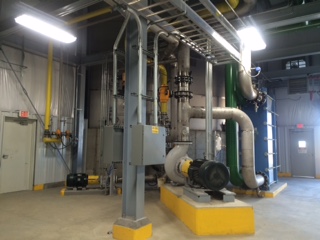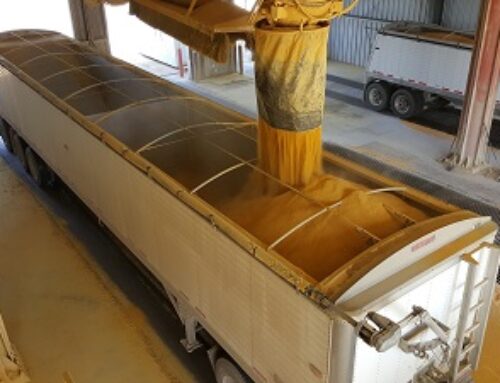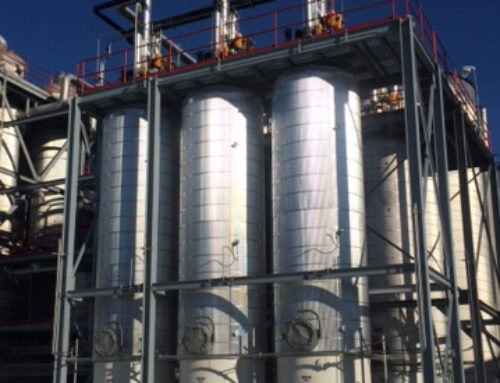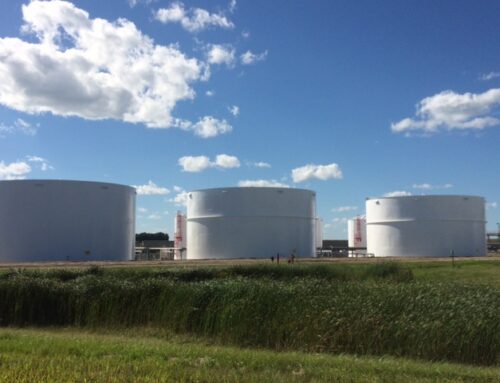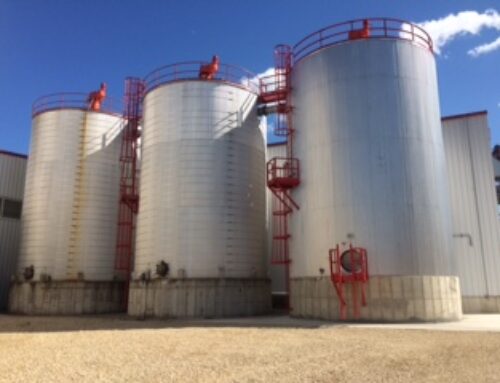In our last newsletter we started an effort to give our shareholders insight into how ethanol is made at Homeland by putting together a four part series describing the intricacies of ethanol production. The focus of Part 1 was Corn, Grain Receiving, Grain Storage, and Grain Cleaning/Milling. The focus of Part 2 will be Slurry, Liquefaction, and Fermentation.
Slurry –
Homeland’s slurry system consists of two tanks. In the first tank, the flour that leaves the hammermills is conveyed over to our process building and combined with recycle liquid streams in a blender to make approximately a 32% slurry solution called mash. In order to keep the viscosity (how easy it flows) down we add our first enzyme, Alpha Amylase. This enzyme is used to break down the starch in the corn into long chain sugars. In order to maximize the performance of this enzyme, temperature and pH must be controlled. Steam is added to the tank to get/keep the temperature around 185 F, and anhydrous ammonia is added to keep the pH in the 5.4 – 5.6 range. Ammonia and steam are required because our recycle waters have a combined pH less than 5 pH and our corn is also much colder than 185 F even after milling. The heated, pH adjusted, mash is then pumped over to a second tank to be further mixed and heated if necessary to get to 185 F before going to liquefaction.
Liquefaction –
The mash that leaves our slurry system is pumped forward to a series of three Liquifaction tanks. It takes just under three hours for the mash to make its way through these tanks which gives the Alpha Amylase enzyme time to efficiently break down the starch in the flour into the long chain sugars. No additional heating is required in Liquefaction to maintain the 185 F temperature due to everything being very well insulated. Homeland was originally constructed with two Liquefaction Tanks but with our increase in rates, the 3rd tank was added to get us back this critical hold time.
“A good rule of thumb to use is for every 3 pounds of corn, the yeast will produce 1 pound of ethanol and 1 pound of CO2.”
Fermentation –
The 185 F mash that has been held for just under 3 hours in our Liquefaction system is now ready to go to Fermentation. This stream is cooled down 93 F on the way to the fermenter so the yeast that will be added won’t die off right away. It is also pH adjusted down to a 5.0 pH to minimize bacterial growth in Fermentation. Once cooled and pH adjusted, the mash is sent to one of our eight fermenters. It takes approximately 7.5 hours to fill one of these Fermenters during which time we add cream yeast, Gluco Amylase enzyme, antibiotic, a couple proprietary enzymes, yeast vitamins, an anti fouling agent, and liquid Urea.
The three enzymes that are added break the long chain sugars down to simple sugars as efficiently as possible so the yeast can convert it to ethanol and carbon dioxide (CO2). A good rule of thumb to use is for every 3 pounds of corn, the yeast will produce 1 pound of ethanol and 1 pound of CO2. The remaining 1 pound is not used by the yeast and will eventually end up as animal feed.
Yeast is a living organism and our fermentation efficiency is directly related to how happy the yeast are. We give them vitamins, nitrogen in the form of liquid urea that is required to produce ethanol, and try to keep them cool. As yeast complete the conversion of sugar to ethanol and CO2, they generate heat just like we do when we eat. The warmer it is, the less people and yeast want to eat. If the temperature gets up to 96 F, the yeast will start to die off. To prevent all of this from happening, the Fermenter is circulated thru a cooler. We add antibiotics to eliminate bacteria from competing for the sugar with the yeast and reducing our efficiency. Once the fermenter is filled, it will be held, circulated, and agitated, for an additional 2 days.
At this point the alcohol concentration is over 16% by volume as the yeast have converted all the available sugars to ethanol. Again, as the plant rates were increased, our Fermentation time was reduced and by adding our 8th Fermenter, we are able to gain additional time to efficiently convert the sugars to ethanol. The CO2 that is produced goes thru a water scrubber to recover any ethanol vapor and minimize emissions before being released to the
atmosphere.
Part 2 can be summarized as simple as the starch that comes in with the corn/flour is broken down by enzymes into sugar and the yeast converts this sugar into ethanol and CO2. In the next quarterly newsletter, Part 3 will focus on how we take the alcohol that is produced in the fermenters and produce fuel grade ethanol.

